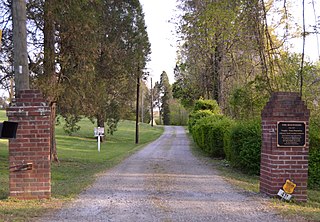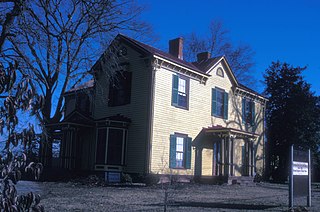
Oakwood Historic District is a national historic district located at Hickory, Catawba County, North Carolina. It includes work designed by architects Wheeler & Stearn. It encompasses 50 contributing buildings, 1 contributing site, and 1 contributing structure in an upscale residential section of Hickory. It includes notable examples of Colonial Revival, Bungalow / American Craftsman, and Queen Anne style architecture dating from the 1880s to 1930s. Notable buildings include the Robert E. Simpson House (1922), Walker Lyerly House (1913), Cline-Wilfong House (1912), Abel A. Shuford, II House, Paul A. Setzer House (1927), John H. P. Cilley House (1912), (first) Charles H. Geitner House (1900), Benjamin F. Seagle House, David L. Russell House, Robert W. Stevenson House, Jones W. Shuford House (1907), Dr. Robert T. Hambrick House (1928), Alfred P. Whitener House, and J. Summie Propst House (1881-1883).

Pine Hall, also known as Anderson-Hanes House, is a historic plantation house located at Pine Hall, Stokes County, North Carolina. It was built in 1859, and is a two-story, three bay by two bay, Greek Revival style brick dwelling. The front facade features a one-story portico with a hip roof and paired heavy Doric order pillars. Also on the property are a number of contributing outbuildings and a family cemetery.
Gentry House may refer to:
Sharpe House may refer to:

Ravenscroft School, also known as Chateau Nollman, is a historic school building located at Asheville, Buncombe County, North Carolina. The oldest section was built about 1845, and is a two- to three-story brick building in the Greek Revival style. It consists of a squat, three-story, pyramidal-roofed tower with projecting two-story rectangular wings. The building has a number of later additions including a two-story brick wing and two-story frame wing. It was originally built as a residence, and housed a school from 1856 to the turn of the 20th century. It was used as a boarding or rooming house until 1977. The building is currently used as office space.

Alphonse Calhoun Avery House, also known as the Avery-Surnrnersette House, is a historic home located at Morganton, Burke County, North Carolina. It was built about 1876, and is a two-story, U-shaped, Late Victorian style brick house. It features 2-l/2-story, squarish, brick tower topped by a mansard roof.

Mountain View is a historic plantation house at Morganton, Burke County, North Carolina. It was built about 1815, and is a 2 1⁄2-story, five-bay, Federal-style brick house. It was remodeled in the 1870s in the Gothic Revival style. It features a two-story gabled porch with decorative bargeboards. Later remodelings added Victorian- and Colonial Revival-style decorative elements.

John Alexander Lackey House is a historic home located at Morganton, Burke County, North Carolina. It was built about 1900, and is a two-story, "T"-shaped, gable roofed, brick farmhouse. It has a one-story, gabled kitchen wing. The house features Colonial Revival style detailing.

Propst House is a historic home located at Hickory, Catawba County, North Carolina. It was built in 1881, and is a 1 1/2-story, Second Empire style frame dwelling. It has a mansard roof, a square mansard tower, and interesting wooden ornament.

Sharpe–Gentry Farm, also known as the John O. Sharpe Farm, is a historic farm and national historic district located near Propst Crossroads, Catawba County, North Carolina. The district encompasses 6 contributing buildings and 1 contributing site. The house was built about 1903, and is a 1 1/2-story, Queen Anne style frame farmhouse. Also on the property are the contributing engine room, shed, granary, garage, and barn.

Warlick–Huffman Farm, also known as the Solomon Warlick House, is a historic farm and national historic district located near Propst Crossroads, Catawba County, North Carolina. The district encompasses 7 contributing buildings, 1 contributing site and 7 contributing structures. The house was built about 1820, and is a two-story, vernacular Federal style frame farmhouse. Also on the property are the contributing Kitchen, outhouse, woodshed, six chicken coops, corn crib, and tackhouse / granary.

Bryan House and Office is a historic home and office building located at New Bern, Craven County, North Carolina. It was built between 1804 and 1806 on the grounds of the original Tryon Palace. It is a 2 1/2-story, three bay, side-hall plan Federal style brick dwelling. The house was modernized and a rear wing added in 1840. East of the home is a one-story, frame office building on a brick foundation. It was the home of Congressman John Heritage Bryan (1798–1870).

Jerkins-Duffy House, also known as the Clarence B. Beasley House, is a historic home located at New Bern, Craven County, North Carolina. It was built about 1833, and is a 2 1/2-story, three bay, side-hall plan, transitional Federal / Greek Revival style frame dwelling. It has an engaged, full-width two-story rear gallery and one-story wings. It sits on a high brick foundation.

W. F. Smith and Sons Leaf House and Brown Brothers Company Building, also known as Piedmont Leaf Tobacco Co., is a historic tobacco manufacturing complex located at Winston-Salem, Forsyth County, North Carolina. The complex includes two buildings. The W. F. Smith and Sons Leaf House was built about 1890, and is a 4 1/2-story, nine bays long and three bays wide, stuccoed brick building with a stepped gable facade. The former Brown Brothers building, was built between 1890 and 1895, and is a five-story brick building with a mansard roof and hip roof dormer windows. By 1900 both buildings housed tobacco prizeries.

Jones–Wright House, also known as the Polly Wright House, is a historic plantation house located near Rocky Ford, Franklin County, North Carolina. It was built about 1790, and is a two-story, three bay, single pile Late Georgian style heavy timber frame dwelling. It has a low gable roof and brick end chimneys.

Carolina Theatre, also known as the Carolina Civic Center, is a historic movie theater located at Lumberton, Robeson County, North Carolina. It was built in 1927–1928, and is a three-story, Italian Renaissance style brick and terra cotta building. The theatre closed in 1975. It has been renovated and houses the Carolina Civic Center.

The Boxwoods is a historic plantation house located near Madison, Rockingham County, North Carolina. It was built about 1815, and is a two-story, five bay, Federal style brick dwelling. It has a small one-story, gabled frame addition. It has pairs of brick exterior chimneys on each gable end and features a full-length one-story mid-19th century porch.

Gov. David S. Reid House is a historic plantation house located at Reidsville, Rockingham County, North Carolina. It was built about 1881, and is a two-story, "T"-shaped, Late Victorian style frame dwelling. It sits on a brick foundation and has a gable roof and original one-story, rear shed projection and one-story rear kitchen wing. The front facade features a hipped roof entrance porch. It was the home of the home of North Carolina Governor David Settle Reid (1813-1891) from 1881 until his death in 1891.
Fewell-Reynolds House is a historic home located near Madison, Rockingham County, North Carolina. It was built about 1820, and is a two-story, six bay, central hall plan, Federal style frame dwelling with a one-story wing. It sits on a stone and brick foundation and has a steeply pitched gable roof. The front facade features a four bay shed roofed porch.

The Coleman-Franklin-Cannon Mill is a historic industrial complex at 625 Main Street SW in Concord, North Carolina. The recognized complex consists of ten buildings on 6.6 acres (2.7 ha), about 2 miles (3.2 km) west of downtown Concord. Another 4.4 acres are not included. The oldest portion of the mill, now its eastern section, is a brick two-story structure 14 bays long and 9 deep. The historic site also includes some worker housing.

















